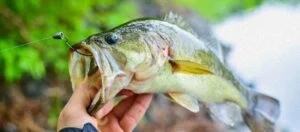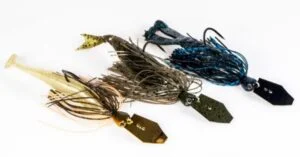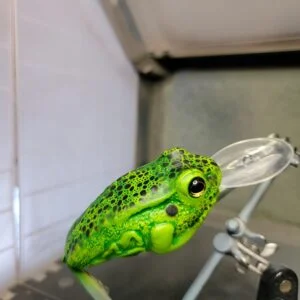 For most of us, late Spring bass fishing is some of the best. I’m talking about the months around May and June.
For most of us, late Spring bass fishing is some of the best. I’m talking about the months around May and June.
By this time, much of the spawn is over with and the lunkers are moving out of their nests and returning to normal.
While it might be an exciting time, late Spring is also known for a “lull” in bass activity. Most anglers call it the “post-spawn blues.” It’s tough to know why exactly this happens but I could guess that they’re simply tired from taking care of the spawn and the female bass in the nest.
No matter what way you cut it, you have to be strategic and aggressive or you won’t get the bass biting.
Understanding the Late Spring Hunt
It’s a confusing time to fish because it can vary dramatically based on a few factors.
The first factor is the gender of the fish. Male bass tend to be a bit slower during this time while females are back out and actively hunting. This is a great time to go after the large female bass that you normally can’t find.
Keep in mind that panfish start their spawn when the bass are done so it often moves the bass a bit deeper in the water when the bluegill and sunnies step in to take over the nest.
Bass are highly opportunistic at this time, similar to how they behave in the Fall. As the water temperatures start to stabilize, bass will seek to ambush unsuspecting prey for an easy meal.
One of the best tips I ever heard when we spoke with Pro Angler Alton Jones: yourbassguy.com/professional-anglers/bass-fishing-tips-from-the-pros/
“Each fish behaves differently,” he said. “Some fish will hit right away. With others, you might have to work them a while before you aggravate them into hitting.
In most cases, the bass aren’t eating. They are protecting their nests from intruders.”
We tend to study and study and think we’re going to know everything about what the bass will do when in reality, it varies so much even on a fish to fish basis.
My best late Spring strategy is to go more aggressive than you would think and really try to tick them off. Bright shining blades, loud chatters and chuggers, and plenty of scented bait will help.
In fact, Brent Chapman told us that he prefers bladed jigs during slow times.
“It’s one of my confidence baits. It’s helped me through some slow times.”Chapman uses a 7-foot-6 Kastking Speed Demon Pro swimbait rod and a Kastking reel that allows him to cast far and slow his retrieve down at times when fishing is tough.
What to Look For in Late Spring?
 It’s important to understand that bass don’t have many predators in freshwater. They’re confident in their ability to target whatever they want which is sometimes what makes them lazy.
It’s important to understand that bass don’t have many predators in freshwater. They’re confident in their ability to target whatever they want which is sometimes what makes them lazy.
Because of their confidence, they expect everything to come to them. This fact tells us that bass prefer to hang out in places where prey will stumble.
Areas like steep breaking points and suspended drop-offs are two of the best places to find late Spring bass.
Due to the steep change in structure, it allows the bass to rapidly change depth without having to travel too far or use up too much energy. Baitfish also tend to funnel through these points in large quantities without suspecting nearby bass.
Keep in mind that late Spring is also home to some pretty murky water. With low visibility, you need to be more aggressive with your presentation. This is something I’ve said two or three times already.
Choosing a bright, flashy, and loud presentation catches the bass’s attention and forces them to strike. If you could pair that with proper placement of your cast you’re sure to increase your chances of getting them to bite.
My Favorite Late Spring Fishing Spots:
Steep Points and Drop-Offs – Points and drop-offs are always a smart choice but identifying them without electronics is tough…to impossible. If you don’t have a fish finder, my: yourbassguy.com/bass/bass-fishing-tips/ best beginner bass tip is to fish a lake that offers maps. Many state park lakes will offer topographical maps of structure and contour changes.
Tributaries – My all time favorite spot to fish throughout Spring and early Summer is an area where one body of water flows into another. This could be a stream, river, creek, pond, or whatever. The water flowing into the lake you’re in brings in a ton of oxygen, microorganisms, and baitfish. As a result, bass will hang out here and they generally skew larger in size because they take over the space and scare away anything smaller.
Drains – If you can find drain pipes, you can find bass. They don’t offer much around them in terms of structure changes so they’re difficult to find on electronics. You likely need to patrol the area around the lake to determine if there is a drain pipe. A great strategy is to bang a crank off the pipe and focus on areas of structure existing around the pipe such as weed beds or wood.
Top Lure Choices for Late Spring/Early Summer
If you haven’t realized by now, this time of year can be tough for bass fishing because it’s incredibly unpredictable. Although, that’s a part of what makes it so fun.
You’ll find fish in all kinds of “mentalities.” Some are post-spawn, ready to feed, and active as could be. Others are still in spawn mode and uninterested in every bait you throw at them.
So, what do you do? My motto is – get loud, bright, and as annoying as possible.
Spinners allow you to cover a lot of water with an active presentation. Plus, you get the reflective blade which cuts through the water and reflects light to help bass see you in the murky water.
Cast towards the bank and work your way back. Also, keep the size of your lure in mind. If you were using a ¾ ounce spinner during pre-spawn, you’ll want to use a ½ ounce spinner during post-spawn and on.
Chatterbaits

Most of the same policies apply here as did with the spinners. Size it up a bit and go with a bright color if the water is murky. Perhaps you live in a place where it warms up earlier in the season and by early Summer, the water is clear.
If that’s the case, you’ll want to go with a naturally colored presentation or something of the craw variety. Either way, appeal to your situation. Chatterbaits are more designed for noise than sight so you don’t want to overwhelm the fish with both if it’s not needed.
Diving Crankbaits
 A shad colored deep diving crankbait is a great choice for when the bass are active. If you hit the water and you find that you’re having no trouble at all but you’re reeling in nothing but ouncers, increase your chances of getting a lunker with a realistic diving crankbait.
A shad colored deep diving crankbait is a great choice for when the bass are active. If you hit the water and you find that you’re having no trouble at all but you’re reeling in nothing but ouncers, increase your chances of getting a lunker with a realistic diving crankbait.
Bang it off rocks and ledges. Most of them dive to around 10-15 feet which is perfect for active transition bass.
Author: Coty Perry – Your Bass Guy
www.linkedin.com/in/coty-perry/

